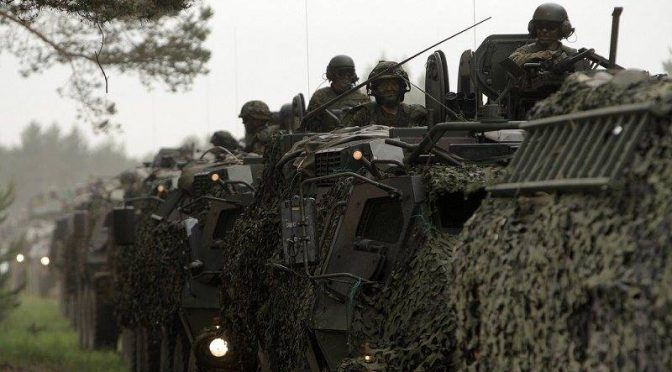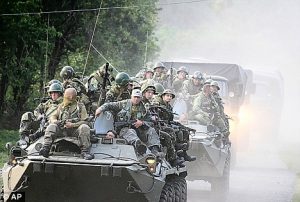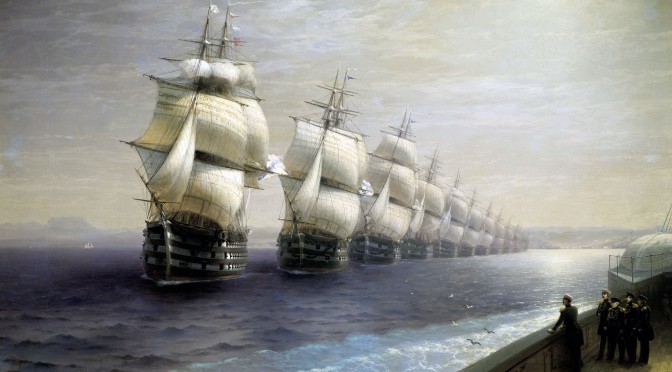By Dmitry Filipoff
CIMSEC had the pleasure of asking The Honorable John F. Lehman, Secretary of the Navy under the Reagan Administration from 1981-1987, questions on his new book Oceans Ventured: Winning the Cold War at Sea. 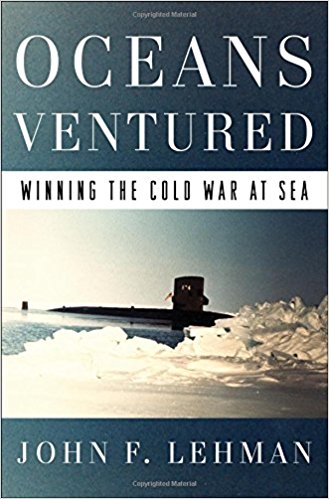
Q: Your tenure as Navy Secretary was guided by President Reagan’s new national security strategy. How did the 1980s U.S. Navy operationalize this new strategy?
A: President Reagan was quite clear in his naval strategy and policy. Eight months before his election, he declared “We have to maintain a superior navy. We are a nation with vital interests and commitments overseas, and our navy must stay ahead of the Soviet buildup. This means commissioning the ships and developing technology which will enable the United States to command the oceans for decades to come.” He believed strongly in the importance of confronting and negotiating with the Soviets from a position of strength – a position based on adequate and appropriate forces as well as the will and capability to use them should that ever be necessary. We in the Navy provided him that strategy. He fully embraced the force goal of a 600-ship Navy and its 15 carrier battle groups and 100 attack submarines, along with the tenets of The Maritime Strategy: Offensive, forward, global operations at sea and from the sea, as a critical component of an aggressive and forward total joint and allied strategy. In this he was fully supported by Secretary of Defense Cap Weinberger, myself as Secretary of the Navy, and a succession of Chiefs of Naval Operations. There was no daylight between any of us on these fundamentals.
The strategy was operationalized through accelerating the Navy’s building and deployment program; developing and promulgating suitable concepts and tactics; gaming those concepts and tactics at Newport and other institutions; and – most importantly and centrally – demonstrating, practicing, and analyzing them at sea, forward and throughout the world, from the very moment the President took office in 1981. This involved both a revamped forward exercise program as well as responding to real-world crises globally on a daily basis. In 1987, when the administration published its first formal public statement of its national security strategy, achieving and maintaining maritime superiority was enshrined as one of its bedrock ideas.
Q: How did the Soviets respond to the new Maritime Strategy and how did it influence their operations and diplomacy?
A: They were aghast. At first, they didn’t know what to make of it, so they responded in kind: Throwing wave after wave of ships and aircraft at us wherever we popped up on their periphery – a periphery that they had long taken for granted as being their own backyard, and as vital launching space for further expansion. We were prepared for this, and indeed welcomed it, using their approaching forces as ‘targeting services’ to help refine our own tactics and to signal to them that the days of a free ride on the world’s oceans had come to an end. They also redoubled their own building program, putting their naval industrial base into overdrive – and in the process helping wreck their own economy. Then, when they saw we weren’t backing down, they began to tend to their own defenses, and started pulling in their horns, circling their wagons. This of course, was exactly what we had in mind, as it eased the pressure they had been putting on Norway, Japan, and other forward allies, and on American and allied forces facing them in Europe and Asia. They were particularly taken aback by the prowess of our commanders at sea in cover and deception operations. To kill a ship you need to find it first, and our commanders stayed up nights thinking up ways to bluff, trick, hide, and conceal their forces at sea so that they couldn’t be found. They also railed against The Maritime Strategy loudly and publicly. “Remarkably odious,” Izvestia snarled. “It is hardly possible to imagine anything worse.”
They had their own tricks, of course, in the form of American spies – sailors and government civilians – who were delivering our plans and orders to them by the trash bag-full. And they exploited these greed-heads to the maximum extent that they could. Finally—and this we hadn’t planned as extensively for – they started a massive propaganda campaign calling for a wide range of naval arms control measures that would barely affect their own capabilities but that would hamstring us to a fare-the-well. Fortunately, not just the U.S. Navy but the U.S. nation rose to that challenge, dismissing their proposals for what they were – ploys to cut and constrain our vital naval capabilities while giving them the protection they now craved, and leaving us vulnerable to Soviet challenges at sea. At the very end of the decade, they began shutting down their far forward operations and facilities in Africa and elsewhere, and scrapping hulls that they had kept in their inventory far past their useful lives. But they continued – right up until the Soviet Union disappeared – to throw a multitude of new well-armed hulls in the water – a challenge we had to pay attention to until their country was no more.
Q: How did American maritime superiority contribute to the end of the Cold War and the collapse of the Soviet Union?
A: American maritime superiority made essential contributions. It ensured that their far forward forces – like those in Cuba, Africa, and the Indian Ocean – would not be available in a fight, and that our own considerable allied and forward forces always would be, reinforced and resupplied from North America. Maritime superiority meant we could threaten them from all directions, at once or serially, flexing our forces to come at them in the Norwegian Sea, the Arctic, the eastern Mediterranean, and the western Pacific, and reinforcing their need to protect and defend their forces close to their homeland, instead of surging out into the broad oceans and threatening our own shores. American maritime superiority meant that their strategic ballistic missile submarine force – on which their warfighting doctrine relied as a necessary nuclear strategic reserve – was not going to survive the early days of a war, should our president so decide. Finally, American maritime superiority meant that they could never catch up. We would always strive to be ahead of them – and succeed, no matter how many new ship classes they constructed or spies they paid off. As President Gorbachev plaintively remarked in 1989 to President Bush on board the Soviet cruise ship Gorky off Malta, “We are encircled by your Navy.”
Q: The book takes its title from a major exercise, and it is heavily focused on exercises throughout. Why this specific focus? Why are these exercises valuable for naval forces and national security writ large?
A: The Maritime Strategy included a host of interlocking initiatives, but none were more important than the forward at-sea exercises. Like other exercises, they had a number of vital and worthy goals: To train, to test, to experiment, to practice, to hone. But much more importantly, these exercises – especially the very earliest ones like Ocean Venture ‘81 in the Norwegian Sea and its initial companion exercises in the North Pacific – were designed to – and did – send the most powerful of all signals to the Soviets: Presidential candidate Reagan’s “peace through strength” campaign motto was now firm U.S. policy, not a discarded slogan. They also signaled to the plucky Norwegians, our other NATO allies, the Japanese, the South Koreans and others that we once again “had their back.” We really did. And they signaled to those naysayers among the defeated Democrats and in ground combat-oriented American and allied headquarters to get on board, because this President and his like-minded appointed officials were serious, and in charge.
And yet – despite all that has been written about The Maritime Strategy and its effects – including my own work – there hasn’t been much attention paid to the exercises. Operators go to sea and scribes do the writing, and the scribes – even the operators among them – have short-changed the role of the exercises in favor of learned dissections of the role of secret intelligence or wargaming, or exegeses on the evolution of the documents, or any of the many other elements that came together to comprise the “perfect storm” of The Maritime Strategy. This book is intended to put some balance into what had become an important – but unbalanced – literature (see my bibliography). And to pay tribute to the brave and clever Navy operators who devised and carried out these maneuvers – many necessarily in atrocious weather – in the Arctic, the Barents, the Norwegian Sea, the Med, the Sea of O, the Sea of Japan, and elsewhere.
Q: These exercises were often led and designed by leaders with a wily reputation, leaders like Admirals Hank Mustin and Ace Lyons as you discuss in the book. What distinguishes great operational and tactical innovators such as these men?
A: The U.S. Navy is certainly fortunate to have among its numbers a goodly share of “operators” – seamen, aviators, and tacticians who enjoy going to sea and putting warships, aircraft, and their crews through their paces. For them, it’s the ultimate in “fun and zest,” as my old mentor Admiral Bud Zumwalt used to say. They aren’t hard to find in the Navy – everyone knows who the “sea dogs” and “good sticks” are. But it can be hard to place them in senior operational positions where their talents can shine. One of the most important jobs a Secretary of the Navy has to participate in is the identification of those stalwarts, and then ensuring they get assigned top jobs where they can do the most good. I spent a fair amount of time on that when I was secretary, and I believe most of my choices panned out well. And so did the Soviets (see the vignette in the book where post-Cold War Russian admirals are crowding a window to get a glimpse of Ace Lyons at a conference).
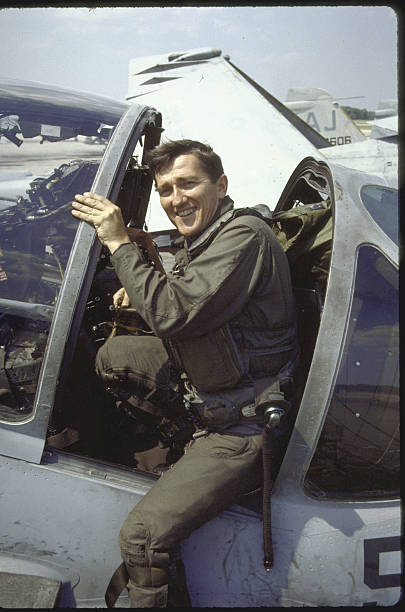
Speaking of Ace, he illustrates another important point as well: Many of the Navy’s most skilled operators are also among its most well-educated and experienced in naval strategy, policy, and global fleet operations. Again, the trick is to identify these folks early on and develop them with alternating sea and shore tours and repeat tours in plans and policy billets so that they can get the necessary breadth and depth of experience once they reach high flag rank. Ace was a famous ship-driver and deception specialist at sea, but he also had had four tours in OP-06 (today’s N3/N5) before being promoted to flag (well before my time, incidentally), as well as tours as a student at both the Naval War College and the National War College. All that, plus his drive, brains and imagination, made him a formidable Navy leader. Hank Mustin – the other famed mariner you mentioned – had a similar special background, including student tours at the Naval Postgraduate School and the Naval War College, a combat tour on the rivers of Vietnam, and several OPNAV tours in surface warfare planning and crafting CNO Zumwalt’s Project SIXTY – an ancestor of The Maritime Strategy. So the Navy has these men and women – with the right education, experience, aggressive mindset, and imagination. It’s up to the top leadership to develop their careers sensibly and move them quickly into the most demanding top positions, even if it means goring some sacred cows like cookie-cutter career patterns and “Buggins’s turn.”
Q: You described a “virtuous circle” that kept strategy current and evolving. As described in the book, it consisted of fleet exercises that fed into the work of key institutions like the Strategic Studies Group, the Center for Naval Analyses, the Naval War College, and others, who then informed new fleet exercises. Please discuss how this virtuous circle worked.
A: It worked in a number of ways, all essential. First of all, there were the formal linkages. For example, the Navy’s educated and experienced strategists in OP-603 crafted Maritime Strategy briefings that were used by OPNAV and the Secretariat to kick off the POM development cycle each year. Many OP-603 officers had had Naval War College or similar civilian educations that had taught them the principles of naval strategy. These experts also briefed their products to the CNOs and myself, to the Strategic Studies Group (SSG) and the professoriat at Newport, and to a host of others – in the other services, on the Hill and overseas, for example. They listened as much as they briefed, and brought useful new insights back with them to update and polish their briefings. Meanwhile, I was providing the essential political direction that was sorely needed to shift the Navy to a more aggressive posture, and my staff ensured that my speeches and other emanations found their way to OP-603, the SSG, and other homes to direct and influence the growing strategy and the 600-ship Navy program. It took a couple of years of this iterative process before the ever-changing and ever-improving slide decks could be converted to actual documents, but they eventually were. Having benefitted from all these inputs, they proved extraordinarily influential.
Meanwhile, the SSG used its freedom and high-level access to explore extensions, variants, and alternatives to facets of the strategy, and fed them to myself and the CNOs. Some then found their way into the next iteration of the strategy briefing. The fleet commanders – supported by their seagoing CNA operational analysts – debriefed their strategy-influenced exercises extensively, within the Pentagon and on the Hill. Programmers and budget-crafters thus heard firsthand how the strategy – and their programs – were faring forward at sea, facing off against Soviet Backfire regiments and submarines. And they learned what needed changing. Meanwhile once per year, the Naval War College convened a Global War Game to examine elements of the strategy. Players included SSG staff and fellows, Hill staffers, OP-603 strategists, Naval War College and Naval Postgraduate School professors, unified command reps and, of course, the fleets and others. They took back to their commands and offices and classrooms the insights they had gained from the games, and submitted recommendations to the gamers on what might be done better or different next year – and to OP-603 to revise their baseline. Overlaid on all of this were inputs from the Navy’s intelligence officers and CNA, which injected important and counter-intuitive “Red” views into the strategy concepts and media, and enabled the strategy to be further developed at various levels of classification.
Then too, The Maritime Strategy benefitted from the Navy’s rotation policies – when intelligently applied. Conceptualizers and practitioners swapped positions regularly. Examples abound: Ace Lyons went from running Ocean Venture and other Maritime Strategy exercises to serving as OP-06, responsible for updating the strategy briefings and documents, then on to the Pacific Fleet, to apply what he knew in the waters off Kamchatka and Vladivostok, through imaginative use of a revitalized and forward-operating Third Fleet. Hank Mustin likewise went from running imaginative exercises as COMSECONDFLT/ COMSTRKFLTLANT (“Mustin in the Fjords”) to OP-06. And it wasn’t only the flags: CAPT Larry Seaquist, for example, came down from the SSG to run the OP-603 strategy shop, then went on to command USS Iowa at sea in Maritime Strategy exercises, and then on to strategy staff positions on the Joint Staff and OSD. CDR Ray Conrad – one of the Navy’s pre-eminent NATO experts – moved from OP-603 to a destroyer command in which he “walked the talk” in frigid North Pacific exercises, and then moved on to NATO headquarters where he inculcated a generation of allied officers and civilians in the Maritime Strategy’s principles. He was joined there by Peter Swartz, with whom he had earlier worked in OP-603. Swartz subsequently was picked up by CJCS GEN Colin Powell as a Special Assistant during the Gulf War.
And so it went. By the end of the decade, the upper reaches of the Navy – and the Pentagon and the National Security Council Staff – were shot through with officers who had served in a variety of guises in developing and implementing the Strategy, and who also served as mentors to the follow-on generation.
Q: The Navy of 1980 was in many ways still suffering from a post-Vietnam War malaise and had to shift from a power projection focus toward sea control against a great-power adversary, while still maintaining full-spectrum competence. A similar problem exists today. What did it take to reset the Navy’s mindset and skills to meet this challenge?
A: Well, that’s not quite accurate for the 1980s, although it does square with CNO ADM Zumwalt’s views in the early 1970s. What we faced in the 80s was the need to plus-up and advance both sea control and power projection – and strategic deterrence, strategic sealift, and forward presence to boot. We needed more carriers and strike aircraft, more and better amphibs and landing craft, more attack submarines that could work under the ice, more prepositioning and sealift ships to get the Army, Air Force, and Marine Corps where they needed to go. Also, we needed to rapidly introduce into the fleet Tomahawk missiles, Aegis cruisers, Vertical Launching Systems (VLS), and a whole new family of strategic nuclear ballistic missile submarines. We had to do it all. We were up against the Soviet superpower, armed to the teeth and deployed worldwide. And not just their Navy, but the Red Army, Red Air Force, and Soviet allies and clients too.
What it took to reset the Navy’s mindset and skills were three things:
(1) Development and promulgation of a global, forward, and aggressive Maritime Strategy that laid out what we needed to do and how and where we needed to do it, continually re-conceptualized, exercised, gamed, analyzed, discussed, and improved.
(2) A funded force goal of 600 ships, including 15 carrier battle groups, 4 battleship SAGs, 100 attack submarines, amphibious lift for a Marine Amphibious Force and a Marine Amphibious Brigade, and cruisers bristling with Tomahawks and Aegis.
(3) A vigorous campaign to drive and keep costs down, including restoring accountability and authority to officials, not bureaucracies, fixed price contracting, fostering competition, enforcing contract discipline, using common subsystems, technological innovation through block upgrades, terminating unproductive research and development programs, controlling gold-plating and design changes, and cutting bureaucratic layers.
Q: The United States has long been a maritime power. China, after millennia of focusing on continental power, is only recently but seriously focusing on developing its maritime power as a core component of its rise. Russia’s maritime power is a shadow of its Soviet past. What does history tell us about the value of maritime power for great powers and competition between them?
A: Great powers are not great powers without maritime power. And superpowers are not superpowers without maritime superiority. The United States – and, indeed, the entire world – has benefitted greatly from our acting as a superpower ever since World War II. That continues today. It would be a tragedy of the first order – for ourselves and all others—to allow our position as a superpower to slip. Central to maintaining superpower status, however, is maritime superiority. It is U.S. maritime superiority that guarantees freedom of the seas for the world’s commerce, connects us to our allies and innumerable interests around the world, and enables us to use the seas as a decisive global maneuver space, in peace and war.
In my six years in office, under President Reagan, America was spending almost six percent of our gross domestic product (GDP) on defense per year. That investment contributed mightily to our winning the Cold War. Today we are spending just a little over three percent. Given the plethora of challenges that Secretary of Defense Mattis laid out in his recent National Defense Strategy, it is difficult to understand how we will be able to continue to counter those challenges in the future, absent a deeper financial commitment from the American people and their representatives to maintain our maritime superiority and thus our status as the world’s essential superpower. It is the right and necessary thing to do, for ourselves and the world, and as the richest power on earth we can afford it. America can and should do this.
And that maritime superiority must be exercised worldwide and forward. Nelson beat Napoleon off Egypt and again off Spain, not off England. John Paul Jones fought the British off Yorkshire, not off New York. In the earliest and darkest days of World War II, we launched Army bombers from Navy carriers and bombed Tokyo. We won the Cold War at sea off the Kola, Kamchatka, Vladivostok, in the Eastern Med and under the Arctic ice, not off San Diego or Norfolk. Superpower maritime superiority demands forward operations “in harm’s way.” So we must be manned, trained, and equipped to fight and win globally and forward.
Q: Any final thoughts you would like to share?
A: I write this on Memorial Day. We can never forget those who sacrificed so much to bring us where we are in the world today. Sailors, Marines, Soldiers, Airmen, Coast Guardsmen, and civilian government workers and contractors have all given their lives to keep us strong, free, and prosperous. This includes some who died during the very exercises and operations I recounted in my book. They were critical to our winning the Cold War, and we must never forget them.
The Hon. John F. Lehman Jr. is Chairman of J.F. Lehman & Company, a private equity investment firm. He is a director of Ball Corporation, Verisk, Inc and EnerSys Corporation. Dr. Lehman was formerly an investment banker with PaineWebber Inc. Prior to joining PaineWebber, he served for six years as Secretary of the Navy. He was President of Abington Corporation between 1977 and 1981. He served 25 years in the naval reserve. He has served as staff member to Dr. Henry Kissinger on the National Security Council, as delegate to the Force Reductions Negotiations in Vienna and as Deputy Director of the U.S. Arms Control and Disarmament Agency. Dr. Lehman served as a member of the 9/11 Commission, and the National Defense Commission. Dr. Lehman holds a B.S. from St. Joseph’s University, a B.A. and M.A. from Cambridge University and a Ph.D. from the University of Pennsylvania. He is currently an Hon. Fellow of Gonville and Caius College, Cambridge University. Dr. Lehman has written numerous books, including On Seas of Glory, Command of the Seas, and Making War. He is Chairman of the Princess Grace Foundation USA and is a member of the Board of Overseers of the School of Engineering at the University of Pennsylvania.
Dmitry Filipoff is CIMSEC’s Director of Online Content. Contact him at Nextwar@cimsec.org.
Featured Image: USS Nimitz (CVN-68) and part of Carrier Air Wing (CVW) 8: four A-6E Intruders, two S-3A Vikings, six F-14A Tomcats, and four A-7E Corsairs. Second half of 1984. (Newport News Shipbuilding photo)



